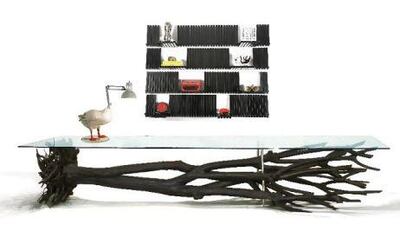Each season several interior trends appear to oppose each other but in fact have common influences and traits. Currently, new minimalism is in vogue, partly because it connects with the austerity of our times and acts as an antidote to the previous decade of decadence and excess. But the simplicity and authenticity found in minimalist interiors and products can also be found in a style we call hunter-gatherer.
It differs significantly from many of the other design trends that we will see in 2012 because of the rawness of the styling. Products are obviously handmade and unashamedly celebrate their natural imperfections. It is the beauty of natural materials in their raw state that gives this trend its honesty; it's a skilled eco-simplicity that everyone can appreciate.
This trend creates a reassuring comfort zone with a rugged edge that nevertheless provides a feeling of protection and connection. It is a "rough luxe" look made up of carved woods, bent willow, macramé, pinched clay, chiselled stone, worked leather and suede, layered feathers, fur trims and felted wool. There are no high-tech manufacturing techniques or complex mixes of materials - products do not even look manufactured. They have simply been manipulated into beautiful forms by skilled human hands.
Many designers are researching, revisiting and reinventing old crafts and using these past skills to create new product designs, particularly furniture pieces. Lex Pott's Fragments of Nature tables allow the organic structure of branches to be showcased; Lund & Paarmann's striking Troll furniture combines oak and sheepskin to create a wild aesthetic; Kaspar Hamacher's Ausgebrannt (burned out) furniture, created by "strategically burning away sections of the wood", transforms simple logs into one-of-a-kind tables and stools; Max Lamb's chiselled seating pieces introduce a caveman styling; The Secret Clubhouse by Martin Vallin for Cappellini provides a safe haven from the outside world.
Although many of these products have a brutal appearance, they also exhibit the designers' great creative skill. This provides a luxurious twist and makes these everyday objects special. Most importantly, each piece is different from the next and celebrates the unparalleled beauty of nature's treasures. No one understands this more than the New York based artist Sebastian Errazuriz, who proposes that "no matter how beautiful or sophisticated our furniture designs might be, they will rarely be able to compare to the shapes we can find in nature".
Errazuriz rescues fallen, dead native trees from forests in South America, then twists and readapts their branches so they can find a new life as a sculptural yet functional piece. His Tree Table would make a dramatic dining table, a unique office desk or a striking statement in a hotel lobby. His furnishings are incorporated in more than 40 international exhibitions in cities such as Tokyo, New York, Paris and Barcelona. "We fortunately have several Middle Eastern clients who have commissioned spectacular pieces. It has been an incredible experience to work with them and they have all been extremely supportive," Errazuriz says.
Victoria Redshaw is managing director of the trend forecasting company Scarlet Opus. For more information on Scarlet Opus visit www.trendsblog.co.uk and www.scarletopus.com For more information on Sebastian Errazuriz visit www.meetsebastian.com or contact Cristina Grajales Gallery, www.cristinagrajales.com

